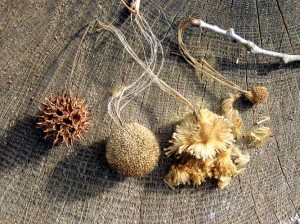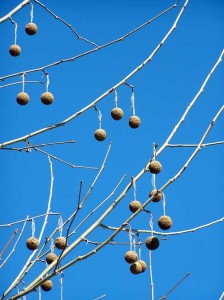Another tree with balls
By Ken Moore
Last week, I admired sycamore balls dangling from a young tree at the northeast corner of the YMCA parking area.
Also last week, Botanical Garden director Peter White shared a digital image of mounds of tawny-colored fluff, sycamore seed, assembled in irregular patterns by the rain running along the curb of his usual Carrboro-to-campus bicycle commute route. During his daily commutes, Peter has become a keen observer of curbside botany. Observing organic debris that accumulates along drainage ditches and gutters offers engaging “what’s that?†puzzles as well as clues to nature’s seasonal actions.
Closer examination shows that the fluff is an accumulation of hundreds of tiny seeds, each seed attached to a plume of fuzzy hairs that, when dry, lifts each sycamore seed far and wide on wind currents.
As described in the Jan 8, 2008, Flora, the mighty sycamore (Platanus occidentalis.) is easily identified by the white color of its upper trunk, easily seen from a distance, particularly in the winter months. The lower trunk of the tree is recognized by contrasting brown and green exfoliating bark. It can’t be confused with any other North Carolina tree. It normally occurs in river bottoms, but is frequently seen in urban areas, because, like other river-bottom trees such as river birch and willow oak, it tolerates harsh urban conditions.
The smooth sycamore balls are fun to compare with the spiky sweetgum balls described in last week’s Flora. Balls of both trees are similar in that they hang on long cord-like peduncles at the ends of tree branches and both are having a major drop during this early spring season. Though the spiky sweetgum balls are dropping now, they dispersed their seed back in the fall.
Sycamore balls are made of countless hairy-plumed seeds that seem to be glued together. The ends of the seeds form the surface of the ball. It is nature’s wisdom that now is the time for sycamore seeds to be dispersed. You will often find flattened clumps of seed fluff on the ground beneath the big trees. You may get a glimpse of the seeds flying above, singly or clustered, or you may be lucky to witness one of those hanging balls suddenly explode to release a cloud of fluffy seed to be carried aloft.
Following the release of the seeds from that sycamore ball, you may find a smaller ball still hanging. That is the very hard core that was commonly used by Native Americans and pioneers for shirt and jacket buttons. If you have an opportunity to examine one close up, you will be impressed by how hard that little center core is, and by the durability of the attached stem, the peduncle, by which it was attached to the tree.

The spiky sweetgum ball differs from the sycamore ball. From left to right: spiky sweetgum ball (notice a few tiny seeds in upper left); intact sycamore ball, seed ends making the outer surface; sycamore ball exploded, displaying numerous hairy plumed seeds; the inner hard core, a pioneer’s button, still attached to the twig. Photo by Ken Moore.
A good place right now to compare the balls of both trees is below the playground area of Carrboro’s Wilson Park. There are great specimens of both trees with balls on the ground and hanging aloft.
While taking a closer look, pause and wonder how those tiny seeds can become such giant trees, and be awed at the natural mechanism that holds onto those seeds and then disperses them so opportunistically.



Comments are closed.